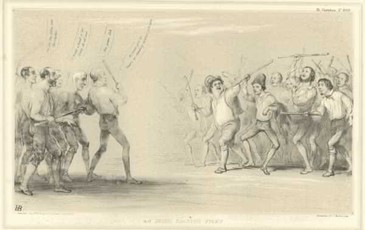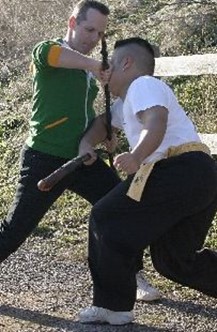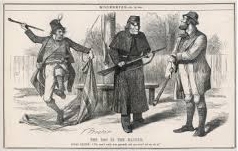Bataireacht is an Irish martial art. It is fighting with a traditional weapon in the form of the Shillelagh, a wooden club, and training in strikes, thrusts, and blocking. What Jujutsu, Eskrima, and Tahtib are to the east, Ireland created their own rich history of martial arts and weaponry, one of which is Bataireacht.
Bataireacht Has Deep Roots
Historians believe that forms of Bataireacht go back to the Bronze Age. But, it was in the late 1600s that its popularity exploded.
The Penal Laws brought in by the British in the aftermath of the Battle of the Boyne in 1690 saw Irish Catholics prevent from any further acts of rebellion. Unable to own land, weapons, and even horses of a certain height, they could do nothing. Irish Catholics were even unable to serve in the military for fear of the training and skills being used against the British. They banned Irish people from carrying wooden "clubs."
Protestant raiding parties became common. They enforced these laws by randomly inspecting villages and looking for any hidden weapons. That gave rise to the now-famous Shillelagh. By carrying a club that acted as a walking stick, Irish people could avoid any charges of owning weapons under these penal laws and remain armed.

Source: hemamisfits.com
County Wicklow is home to the oak forest of Shillelagh, where they made weapons from blackthorn root-wood, which sprouted into a knot, creating the handle for the 'walking stick.' As the popularity of Bataireacht has dwindled, the stereotype of the 'fighting Irish' became ingrained in society.
Shillelaghs can be found in any tourist gift shop across Ireland; however, its history as a deadly weapon gets overlooked in favor of a more majestic narrative of the ancient land of lucky leprechauns. As faction fights grew less common, Bataireacht became less popular. So, how has it seen a resurgence? And where does it go from here?
Modern Day Bataireacht Warriors
Glen Doyle teaches in Ontario, Canada, where the Celtic martial art lives through six generations. "If you didn't have the surname 'Doyle,' you didn't learn it – my dad was really strict on that."
Despite this style of martial arts being exclusive to the Doyle clan, Glen Doyle has been the pioneer to outside of the family name, which required his father's blessing. "I was his only son," notes Doyle, who was itching to share his experience with others. "I said to him, 'Dad, if I'm walking across the street one day and I get hit by a car, the system is done."

Source: pinterest.co.uk/gooseallen
Doyle began training in 1972, at seven years old. His father, Gregory Doyle, was a Canadian veteran with a boxing background. He often said stick-fighting saved his life during the Korean War on more than one occasion.
Glen continues to teach tradition rather than expanding to a contemporary audience. "I had to make the choice: do I keep the integrity of our system, or do I try to modernize it, open it up, or try to get it expanded at the cost of lineage and technique. I didn't want to do that, because it wouldn't be the way to honour my dad's memory."
Bataireacht Passed Down Among Generations
He explains how the techniques survived for so long, "The Shallelagh stick fighting system that I was taught was born on a battlefield. If a technique did not work, you had your head bashed in. The techniques that did work during the faction fights were the ones that got passed on."
This limited his reach to new audiences in the ever-expanding world of M.M.A., but tradition takes precedence for this branch of Bataireacht. Bernard Leddy of Traditional American Combatives (T.A.C.) in Belcoo, Fermanagh, Ireland, went from training in Aikido to the Doyle family style of Bataireacht following an injury.
"I was injured at work, which stopped my training for a couple of years. I had a couple of operations and gained loads of weight. The doctor advised me to lose weight, and so I traveled around looking for a martial art path different from my previous experience, but alas, I could not. Dejected, one night, it struck me that my life had been perpetuating other cultures martial systems, what about my own Irish culture.
I researched Irish martial arts, and up came Doyle family-style Shillelagh stick fighting system. Being a nerd, I researched it and researched it and contacted Glen Doyle and asked if he would train me, and the rest is history."
Bernard went on to discuss how the regular training sessions begin. "Well, we start with warmups, then drills, either against pads or sticks. I then work on a topic with attacks and defence and then we finish on forms, sparring, or competition. "Our focus is always to end the fight as fast and as hard as we can.
In Bataireacht, traditionally, you would fight more than one assailant so, we train to fight hard, fast, and conserve energy. I also focus on the self-defence aspect of training and to have that mindset when training in the club or solo. We are a traditional style, and I don't mix it or dilute it."
Growth of Bataireacht
With Glen Doyle teaching outside of the Doyle name, Bataireacht might see a popularity shift back in its homeland. "I train perspective coaches here at my home in Leitrim, Ireland. My goal is bringing it back into the Irish mainstream, to make it as common as any other sports but not diluted or corrupted. I want to promote it and to make it accessible to everyone in the community and to persevere the system for the future."
Dan Kanagie of T.A.C. started training in Bataireacht 17 years ago, and traditional values meant that he almost turned away from training altogether.
"I found John Hurley's book online and read it. I found out he was in my city, Philadelphia, PA, so I asked him to teach me. He turned me down due to me not being catholic. Soon after, I met Ken Pfrenger online and then found Glenn Doyle.
He sent me a stack of notes detailing the basics. From there, I had enough to start. Ken Pfrenger became a close friend and mentor in my hoplological journey and studies."
Unlike Doyle and Leddy, Dan does incorporate many other styles into his training due to his extensive background.
"I started researching and training Anglo-American Pugilism in the mid-1980s. I started general W.M.A. in 2001, training in German and Italian sword fighting. From there, I learned about Elizabethan English, Irish, and then American Martial Arts… I teach a few styles of Bata based on their lengths.
Evolution of Bataireacht
I mix with a Bata Trois with some English Great Stick and French Grand Baton. I mix Bata Pionsa with English Single Stick. Bata Shillelagh is mixed with Pugilism, Gaelic Kicking, Collar and Elbow Wrestling. I also add in some Savate, Bowie Knife, Tomahawk, Catch as Catch Can Wrestling."
While Dan would also like to see Bataireacht become more mainstream, the expansion of teaching establishments could bring safety concerns. "I want more people to see and feel how great and complete of a system I.M.A. actually is. But with people and scammers out there, I am afraid it is going to be appropriated by those just looking to make a buck. I have already found one school that is teaching Eastern stick just using the Shillelagh. They are teaching the wrong grip and blocks, which will only lead to one of their students getting hurt."
Instruments of Bataireacht
Francis McCaffrey of McCaffrey Crafts is a 5th generation Shillelagh maker-based Killorglin, Ireland. He is a strong advocate for Celtic martial arts becoming mainstream.
"It's paramount that the history of Shillelagh Irish stick fighting has a voice. I live and work in Ireland and try to be a vocal as possible on this topic. I find all debate is good once people are thinking about Bataireacht."
A handmade Blackthorn Shillelagh that can be purchased at McCaffrey Crafts.
Francis has also had to use his training in dangerous circumstances. "I had had two instances in recent years where I had to use my blackthorn walking stick quickly in self-defense once against an aggressive drunk and another time against someone trying to get into my premises."
Maxime Chouinard discovered Bataireacht when traveling Ireland over ten years ago and now teaches it twice a week with his brother in law and runs a website dedicated to the art form here.
"I was traveling in Ireland, a country that always interested me because of my Irish roots. We were not planning to teach it but were given permission, and we felt that we needed to do something to keep this art alive. It pushes me to always go farther, and it gives me a sense of purpose to help carry this flame."
Maxime splits his classes into different intervals when training yet still tries to keep the classes as loyal to the historic martial art as possible. "I divide my classes in 20-minute intervals. Twenty minutes of warmup and workout. Twenty minutes of specific techniques, 20 minutes of focused sparring, and 20 minutes of free play. When I fight, I sometimes use techniques from other arts I know, but I try to separate Antrim Bata from anything else when I teach it."

Source: irishstick.wordpress.com
Unlike many eastern martial arts, there is no strict grading structuring for students of Bataireacht. "We have instructor levels being Assistant Instructor, Instructor, Propast, and Maistir. There are no student levels; everyone is judged by their skill level. Sticks can be provided, but we usually ask them to bring their own if they come regularly. We use padded fencing helmets, padded vests, gloves, and hard protectors for legs and elbows."
Maxime would also like further mainstream exposure of the art form but is also wary. "I would love for Bataireacht to become recognized as the great martial art it is. That said, I feel we must be wary of keeping our soul and identity in the process and not lose ourselves in the trappings of success."
The Future for Tradition
It is safe to say that Bataireacht sees a resurgence as more people are learning about the art form and its fascinating heritage. The question remains if its traditional roots can flourish without diluting its identity for the sake of broader appeal.
Main image source: Celticlifeintl.com
Frequently Asked Questions
No, owning a shillelagh, which is a traditional Irish walking stick or club, is generally not illegal. However, regulations regarding carrying or using it as a weapon may vary depending on local laws and circumstances.
Can You Take a Shillelagh on a Plane?
Generally, it is not advisable to bring a shillelagh on a plane as a carry-on item. Airport security regulations typically prohibit carrying any objects that can be used as weapons, including clubs or batons. It is best to check with the specific airline and airport security guidelines for clarity on what is permitted.
What are Irish Warriors Called?
Irish warriors are commonly referred to as "Gaelic warriors" or "Celtic warriors." They were known for their bravery, combat skills, and fierce dedication to their clans and kings. Additionally, specific groups like the Fianna or the Red Branch Knights are notable in Irish mythology and history for their martial prowess.






